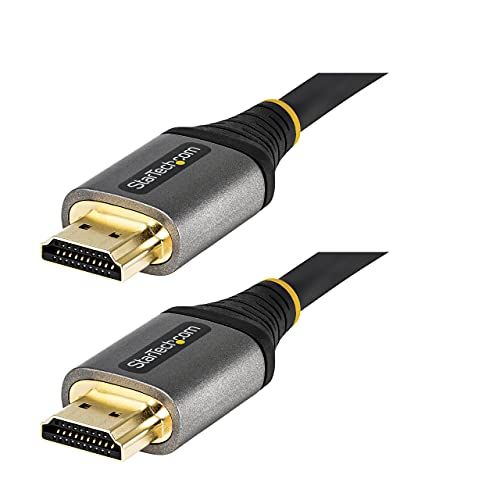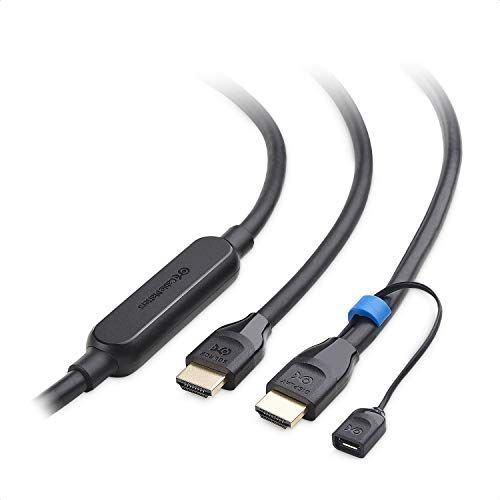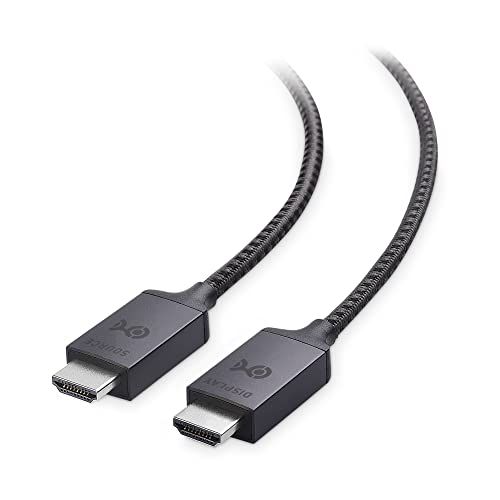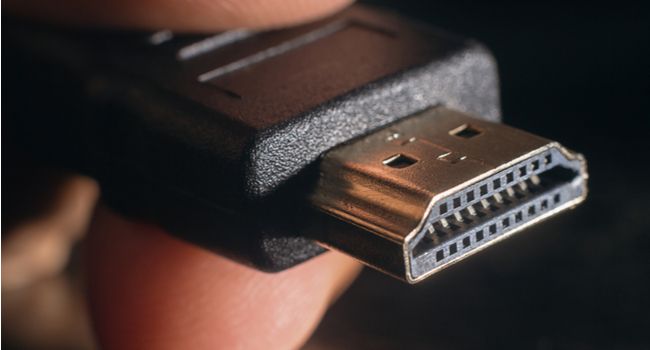Quick Links
Long HDMI cables can come in handy in various situations, from setting up a home theater to connecting digital signage. But is there a limit to HDMI cable length? Here's everything you need to know.
Why Does HDMI Cable Length Matter?
High Definition Multimedia Interface, or HDMI, is the most common display interface today. It's used in everything from televisions to monitors to electronic art. By using a single HDMI cable, you can transmit both audio and video signals from one device to another.
You will find HDMI cables in multiple sizes in the market. Some are around a foot, whereas others are several meters long. But if you are curious about the maximum length of an HDMI cable, no such thing exists. The official standard HDMI specification doesn't recommend a cable length. As long as an HDMI cable meets the performance standards and can successfully carry the signal from one end to another, it can be any size.
However, HDMI cables, like anything else, have to obey the laws of physics. So, any digital signal traveling through an HDMI cable encounters resistance. The resistance level depends on several factors, with the material of the conductor in the cable and its gauge being the most important.
As a result, depending on its conductor and gauge, an HDMI cable can only be a certain length before the signal starts to degrade, leading to artifacts in video or audio output. A reputable brand, however, won't manufacture cables long enough to create those problems.
Maximum Length of an HDMI Cable
As mentioned, the HDMI specification doesn't indicate a cable length. But the HDMI Licensing Administrator, an organization responsible for promoting and licensing the HDMI technology, notes that the early testing in the Ultra High Speed (UHS) Cable program suggests that passive UHS HDMI cables can be up to five meters in length. A passive HDMI cable is your standard HDMI cable, which features HDMI ports on each end connected by shielded copper wiring.
For the uninitiated, the UHS cable is the latest and only type of HDMI cable that meets the requirements to ensure full compatibility with each of HDMI 2.1a's features. So if you are looking to buy an HDMI cable today and want to be future-proof, a UHS HDMI cable is the way to go.

StarTech.com Ultra High Speed HDMI Cable
This StarTech.com HDMI cable has Ultra High Speed Cable certification and it comes with one and two meter sizes.
The older generation passive HDMI cables, such as Standard HDMI (HDMI 1.0/1.1/1.2) and High Speed HDMI (HDMI 1.3/1.4), can be as long as 49 feet, whereas the relatively newer Premium High Speed HDMI cables (HDMI 2.0) are mostly limited to 25 feet.
Active and Optical HDMI Cables
Active and optical HDMI cables can achieve longer lengths than passive HDMI cables. Active cables are able to do this because they use electronic circuits to boost the signal and compensate for any signal degradation.

Cable Matters Active UHS HDMI Cable
Use this powered Cable Matters HDMI 2.1 cable to reach up to 25 ft without signal loss, complete with a port for external power if your source device can't keep up.
Optical cables, on the other hand, use light instead of electricity to move the signal from one end to the other. The light-based signal is less prone to degradation than an electrical signal traveling via copper wires. An optical cable will usually be pricier, however, when compared to its active cable counterparts.

Cable Matters Active Fiber Optic HDMI Cable
This Cable Matters active optical HDMI cable is ultra-high-speed certified. You can get it in different sizes---up to 49 feet long!
Depending on the HDMI generation, the length of an active or an optical HDMI cable can be anywhere between a few dozen to 100 feet. If you need even more length than a single active or optical HDMI cable can offer, you will have to employ HDMI cable extenders.
Plenty of Options for a Long HDMI Cable
As you can see, the maximum length for an HDMI cable is not as cut and dry as you might expect. Fortunately, between passive, active, and optical HDMI cables, you will likely find a suitable cable to meet your needs. And if you need something even longer, you can always use an extender.
That said, stick to reputable brands while buying an HDMI cable and look for the official certification to get the best quality cables. For example, both Premium High Speed and Ultra High Speed HDMI cables are certified by the HDMI Licensing Administrator. The certification will ensure that the cable meets the requirements to support the features offered by its HDMI generation.


